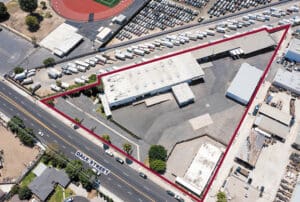Media Coverage
- 2025
- 2024
- Archive
While Elon Musk shifts from DOGE mode back to being the head of his electric vehicle manufacturer, the company is extending its stay in Santa Monica, Calif.
Tesla, one of the most valuable companies in the U.S., signed a 82,000-square-foot renewal for its service shop at 1100 Colorado Boulevard.
The EV-maker first inked a five-year deal valued at $12 million in 2021 with the owner, Culver City-based Thompson Properties. Its fresh lease at the property begins next January.
Musk made waves when he moved Tesla’s headquarters from Palo Alto to Austin, Texas, in 2021 in the wake of California’s COVID-19 restrictions. And last year, Tesla cut 10 percent of its staff to reduce costs and increase productivity, Musk said at the time.
However, Tesla’s factory in Fremont is still said to be the largest automobile plant in North America. And its presence in the Golden State still commands strong property values: A year and a half ago, Westcore paid $326.8 million for three industrial buildings, two of which were leased to Tesla.
(Also last summer, Musk also moved the headquarters for SpaceX from L.A.’s South Bay to Texas, and also moved X (formerly known as Twitter) from San Francisco to Austin due to his criticisms of West Coast politics.)
Daum Commercial Real Estate’s Michael Collins and David Freitag announced the Santa Monica lease and represented Thompson Properties, while Beta Agency’s Xan Saks represented Tesla. The real estate services firm categorized the lease as industrial.
“Demand for space increased during this last quarter, resulting in lower vacancy rates,” Collins said in a statement. “With little new supply coming online, the demand imbalance enabled us to negotiate renewals with favorable terms for our clients.”
L.A. County’s industrial market, particularly in West and South L.A., has remained reliable amid uncertain economic conditions and high interest rates — likely due to proximity to the Ports of L.A. and Long Beach, and tight supply. Direct vacancy in West and South L.A.’s industrial landscape dropped to just over 5 percent in the first quarter of this year, according to a recent report by Daum.
President Donald Trump’s zig-zagging tariff policies are perhaps the largest wrinkle in the problems facing Southern California’s industrial sector, and for vehicle manufacturers like Tesla. The U.S. and China earlier this week agreed to a 90-day pause in tariff escalation for negotiations, lowering their reciprocal duties on goods to 30 percent and 10 percent, respectively. The news boosted stocks on Monday, but Gene Seroka, Port of Los Angeles president, said the truce is unlikely to boost imports in the short term.
Nick Trombola can be reached at [email protected].

DAUM Commercial Real Estate Services completed the 100% lease up of Carson Agua Mansa, a newly constructed, two-building industrial project developed by Carson Companies with 333,101 square feet of space in Jurupa Valley. EVP and branch manager Rick John and EVP Gus Andros of DAUM’s Inland Empire office represented the Carson Companies in the two leasing transactions.
The property consists of two large industrial warehouse buildings and surrounding acreage. Building A, located at 1136 Hall Ave., totals 140,198 square feet. The larger site within the project, Building B, located at 1176 Hall Ave., spans 192,903 square feet.
James Toomarian and Ben Seybold of CBRE represented the tenant of 1136 Hall Ave. Jay Dick, Dedrik Pharis and Doug Norton, also of CBRE, represented the tenant of 1176 Hall Ave.
“Achieving 100% lease up of their spectacular new facilities is a great achievement for the Carson Companies,” said John.
Industrial Site Sells for $87 per Square Foot

A 2.6-acre property with four industrial buildings in Stanton sold earlier this month for nearly $10 million.
Sun Coast Shipping LLC, a logistics company based in Corona and affiliated with Duarte-based firm Dynamic Export LLC, bought the 112,820-square-foot property at 11121 Dale St. and 11081 Dale St. for $9.8 million, or $87 per square feet.
Stanton-based vehicle shipping company California Shipping Inc. was the seller. Anthony Bergeman, Michael Chase and Krishna Shegran of DAUM Commercial Real Estate Services represented the buyer.
Chase said Sun Coast Shipping could use the industrial outdoor storage, or IOS, property as a truck terminal. IOS properties, Chase continued in a statement, “has seen strong interest from investors in recent years, including institutional portfolios.”
The property includes a freestanding 19,375-square-foot building with 5,400 square feet of office space, loading docks and covered outdoor storage. Also on the property is a 4,000-square-foot building with a ground-level loading door.
California Shipping Inc. used the property as a base to ship boats, motorcycles, personal items, trucks and vehicles overseas.
Also working on the transaction on behalf of the seller were Mike Barreiro, Dennis Holt and Devin Ray of DAUM’s Newport Beach office.
Daum Commercial’s Rick John on the benefits of looking westward for investments
 The industrial sector has proven itself to be a highly resilient asset class that has continued to draw investor interest, even over the turbulent past few years for commercial real estate. While transactions remained at nearly a standstill for the majority of 2024, there was steady demand for well-positioned industrial assets.
The industrial sector has proven itself to be a highly resilient asset class that has continued to draw investor interest, even over the turbulent past few years for commercial real estate. While transactions remained at nearly a standstill for the majority of 2024, there was steady demand for well-positioned industrial assets.
Industrial is appealing to investors seeking a hedge against inflation to preserve capital. While still elevated slightly from their historic lows, cap rates are compressed, with most transactions closing at sub-5 percent cap rates in prime markets. It was also the only major product type to see a decrease in loan delinquencies in the fourth quarter, a further testament to the sector’s stability through an evolving economic landscape and unprecedented global events.
Yes, there have been persistent headlines of oversupply and softening demand in Los Angeles County and the Inland Empire and attention being driven toward emerging markets in the Southeast and Midwest. That said, Southern California and other Western markets remain critical hubs of commerce and logistics that will continue to benefit from the same demand drivers and fundamentals that have historically propelled these regions. In fact, there are emerging submarkets within these regions with strong growth potential that are attracting businesses, developers and investors alike.
Strong outlook for demand drivers
Even in the face of a new administration and geopolitical uncertainty, Western markets in particular remain a key hub for both global and domestic commerce. In 2024’s fourth quarter, year-over-year volume at Southern California’s San Pedro Bay Port Complex (home to the ports of Los Angeles and Long Beach) was up 19.5 percent, according to Freightos data, and costs per container from East Asia to the West Coast declined 13 percent.
While some investors are still hesitant to make moves amid headlines of rising vacancies resulting from significant deliveries, strong absorption rates indicate that these will likely begin to fall again in 2025. In fact, throughout the Inland Empire, average gross and net absorption rates were up in the fourth quarter as a result of stronger demand.
From an overall economic standpoint, higher employment rates and improving sentiments are signs we will see industrial users making moves. This will create ample opportunity, as many tenants are poised to strategically navigate their own growth and invest in their supply chains this year. At DAUM, we’ve assisted several companies, including retailers and distributors, with expansions this past year and expect this kind of activity to continue.
Opportunities in emerging submarkets
We’re even seeing new and planned construction of state-of-the-art distribution centers and mega-warehouses in historically underutilized areas of the Inland Empire and Los Angeles County that still have ample developable land.
One example of this is L.A. County’s Antelope Valley, which is located just an hour from the ports, north of the city of L.A. and just west of the Inland Empire. With growing business and residential populations, an educated workforce and a business-friendly government, it is poised to continue attracting businesses and represents an area of industrial growth and fertile ground for investment.
Industrial users, including logistics firms and manufacturers, are attracted by the region’s affordability, given that rental rates remain high in submarkets near downtown Los Angeles. Additionally, drayage costs to the Antelope Valley are the same as to Beaumont and Banning and lower than the High Desert, Tejon and the Central Valley.
In fact, DAUM agents recently arranged the sale of 68.5 acres of land in Lancaster—fully entitled for a 1.26 million-square-foot distribution center—to Amazon.
Especially as the logistics industry continues to increase its capabilities of next- and same-day delivery, there remains strong demand for quality industrial space near key population and transportation hubs.
Rick John, SIOR, is executive vice president at DAUM Commercial Real Estate Services.
Chow Tai Fook and Gem Hooray, a Hong Kong-based jewelry company, recently opened their first US store at the Brea Mall.
The jewelry store is on the upper level of the mall, between Lush and Chrono Toys.
Chow Tai Fook is nearly 100 years old, opening in 1929 in Guangzhou, China. The company operates thousands of stores in mainland China. It specializes in jewelry in either 18 karat or 24 karat gold.
Prices start in the low-hundreds for gold items. See more of their selection online at gemhooray.com
DAUM Commercial Real Estate Services closed the lease deal on behalf of the mall owner, Simon Property Group.
DAUM Commercial Real Estate Services directed the acquisition of an approximately 5,000-square-foot restaurant space at 1212 S. Baldwin Ave. in Arcadia to Dream1212 LLC, the owner of Mama Lu’s Dumpling House, a traditional Chinese restaurant with several locations throughout Southern California. The purchase price was $4 million.
The Arcadia property now serves as Mama Lu’s sixth location, said DAUM EVP Rudy Lara, based out of DAUM’s South Bay office. “With its flagship shop in Monterey Park, Mama Lu’s already has a strong following in the San Gabriel Valley, and our client was looking to expand its presence in the area with an Arcadia location,” Lara said.
Lara added that the acquisition is part of a rapid expansion of Mama Lu’s, with the openings of Beverly Hills and Las Vegas locations planned for early 2025. In addition to Rudy Lara, the DAUM team included VP Nick Peukpiboon and DAUM’s Nathan Lara and Andrew Lara.
A 39.8k sf manufacturing and distribution industrial building in Tempe, AZ traded hands in a $7.3 mil ($183/sf) deal. The property is located at 1326 West Fairmont Drive.
The asset acquired is centrally located in Tempe, with close proximity to major freeways and Sky Harbor Airport. The building, which features seven dock doors and heavy power to accommodate both manufacturing and distribution uses, was the investor’s first purchase in the Tempe market.
Parker Houston, Chris Rogers, and Trevor McKendry with DAUM Commercial Real Estate Services represented the private investor buyer in the transaction. The new owner plans to implement additional improvements to the property to better attract quality tenants.
“Arizona is one of the country’s fastest-growing states, and the Phoenix Metro in particular, including Tempe, is experiencing tremendous population growth,” said Houston. “This bodes well for investors in the region’s industrial sector, particularly manufacturing and distribution facilities that serve the area.”
According to DAUM research, several Phoenix industrial market fundamentals improved during Q3 2024, with sales volume increasing 30.2%, leasing activity rising 41.4%, and rental rates growing 1% during the quarter. Industrial properties under construction in the metro have experienced a steady decrease over the last five quarters, an indication that supply is in check and elevating the value of existing properties in the market.